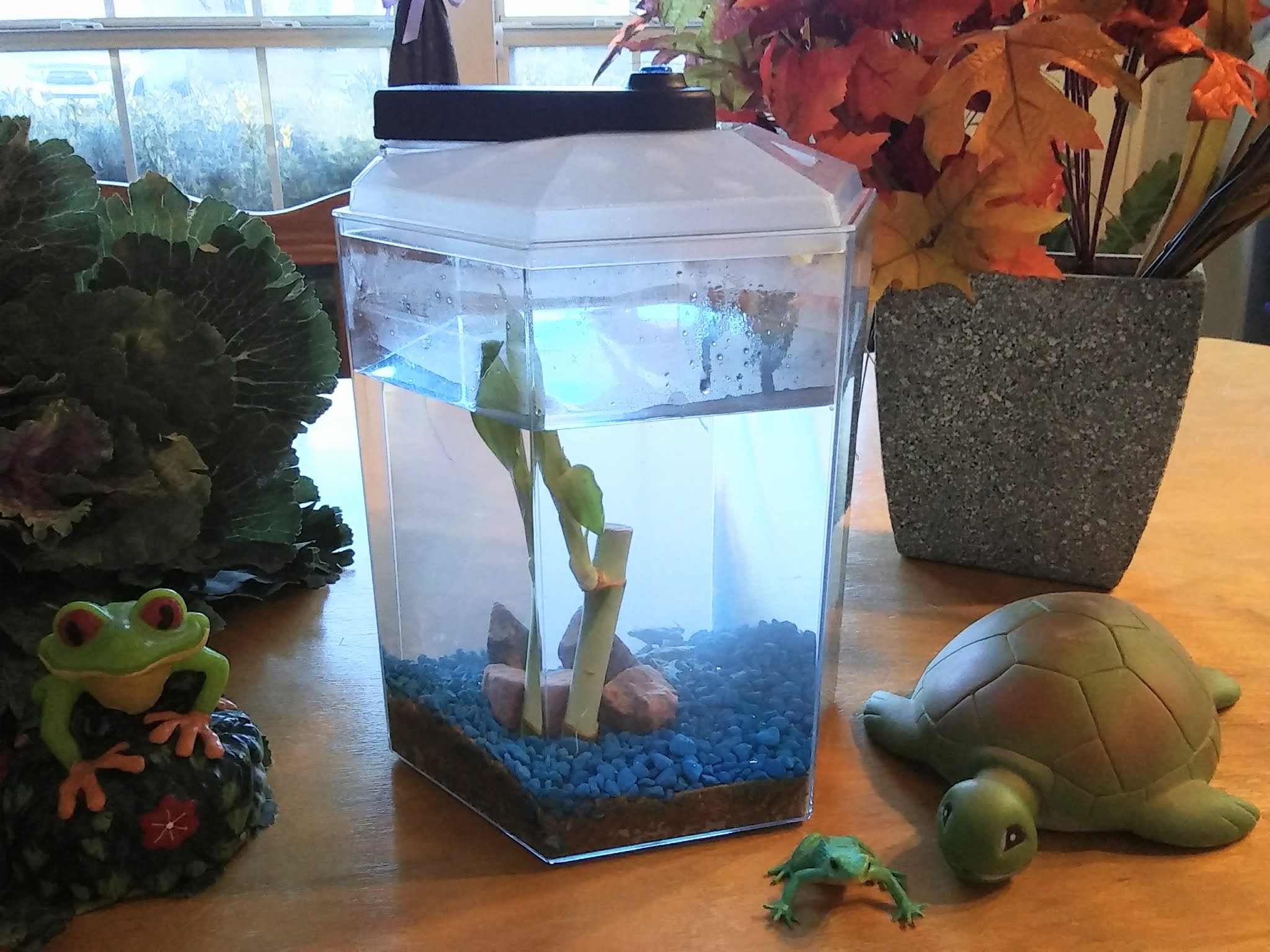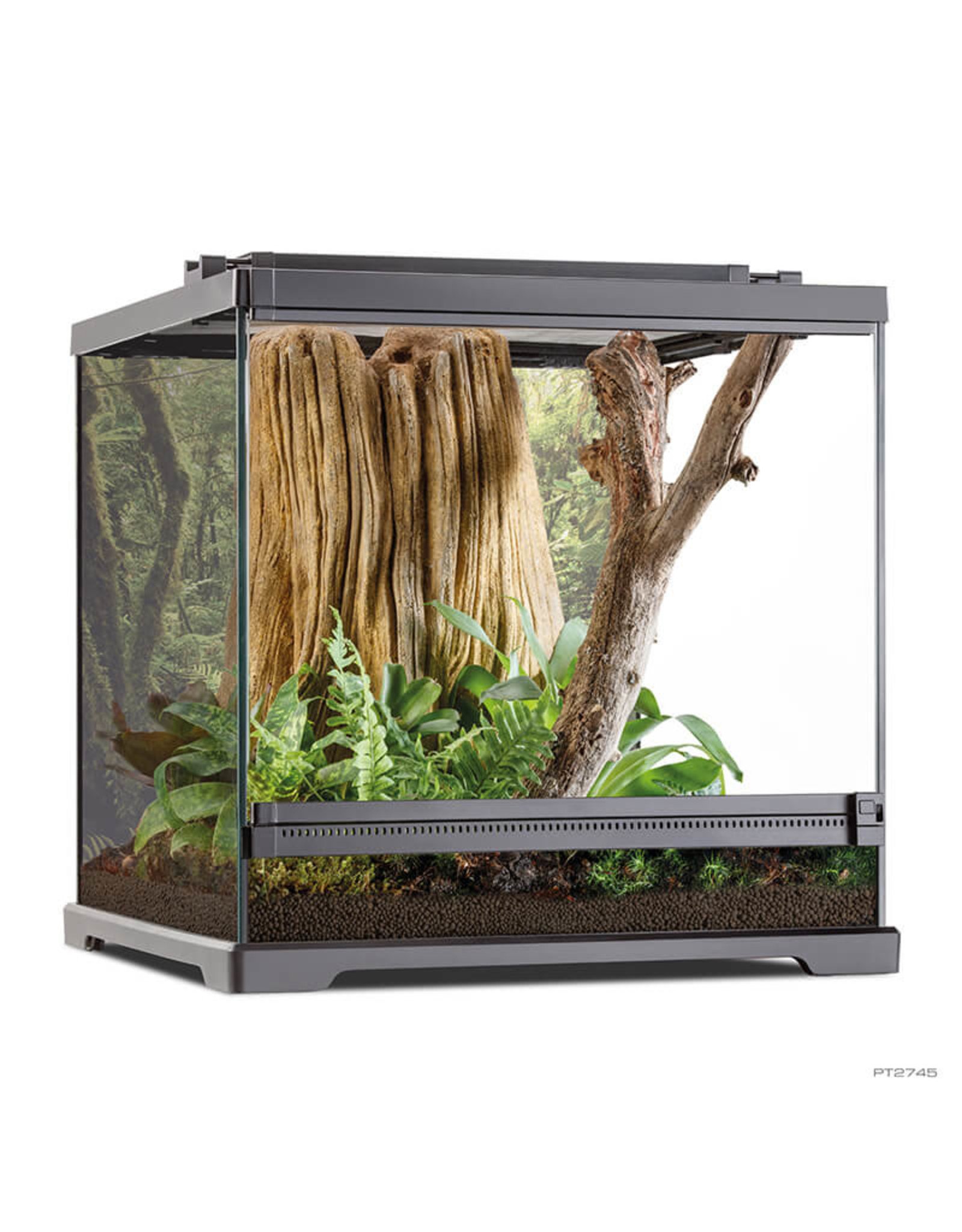A pet frog tank should be spacious, secure, and have the correct environmental conditions. Creating a suitable habitat for your pet frog is essential to ensure their health and well-being.
A well-designed tank will provide the necessary space for your frog to move around comfortably and explore their surroundings. Additionally, it should be secure to prevent escape and keep your pet safe. The tank should also have the right environmental conditions, including proper temperature, humidity, and lighting, to mimic the frog’s natural habitat.
Providing a suitable tank will help create a stress-free environment for your pet frog, allowing them to thrive and live a long, healthy life.
The Basics Of A Pet Frog Tank
Choosing the right tank size for your pet frog is crucial to ensure its well-being. It is important to consider the adult size of your frog species when selecting the tank. You want to provide enough space for your frog to move around comfortably. A general guideline is to have a tank that is at least 10 gallons for small frog species and up to 50 gallons or more for larger species.
The tank material is another important factor to consider. Glass tanks are commonly used as they provide good visibility and are easy to clean. However, plastic tanks can be a more lightweight and affordable option.
Adequate ventilation is necessary to maintain a healthy environment for your pet frog. This can be achieved by providing a mesh lid or air vents on the tank. Good airflow helps to prevent the buildup of humidity and ensures proper oxygen exchange.
Proper lighting is essential for your pet frog’s health and well-being. Most frogs require a combination of UVB and UVA lighting to satisfy their needs for both vitamin D synthesis and general lighting. It is important to research the specific lighting requirements of your frog species and provide appropriate lighting fixtures.

Credit: www.momknowsbest.net
Creating The Ideal Environment
Setting up a suitable substrate for your pet frog tank is crucial for their comfort and well-being. The substrate should be moist enough to maintain the required humidity level but not waterlogged to avoid rot or bacterial growth. A combination of coconut fiber, sphagnum moss, and eco-earth can provide an ideal substrate. Ensure it is deep enough for burrowing and hiding.
Establishing the ideal temperature and humidity are vital for your pet frog’s health. Most frog species require a temperature range between 65-85°F (18-29°C). Installing a thermostat-controlled heating system can help maintain the desired temperature. Additionally, maintaining a humidity level of 60-80% is essential. Using a hygrometer and a misting system can assist in achieving and monitoring the humidity.
Proper heating and cooling systems are essential to regulate the temperature in your frog tank. Using a terrarium heater or an under-tank heating pad can provide the necessary heat. Additionally, installing a fan or air-conditioning unit can help cool down the tank during hot summer months.
Maintaining a natural day and night light cycle is crucial for your pet frog’s natural behavior and overall health. Mimicking their natural habitat, provide 12 hours of light followed by 12 hours of darkness. Using a timer for the lighting system can help automate this process.
Designing An Enriching Habitat
Designing an enriching habitat for your pet frog is crucial to ensure its health and happiness. Incorporating hiding places and caves in the frog tank is essential to create a sense of security and mimic its natural environment. These hiding spots can be made using rocks, logs, or artificial decorations, providing your frog with places to rest and hide. Adding natural decorations and plants such as driftwood, moss, or live plants not only beautifies the tank but also offers a more realistic setting for your frog.
To further enhance the habitat, consider including a water feature. Frogs need access to clean and fresh water for drinking and soaking. An appropriately sized water dish or a small pond-like area with a gentle waterfall can provide the perfect environment for your amphibious companion. Additionally, ensure that the water is dechlorinated and changed regularly to maintain optimal hygiene.
Incorporating climbing opportunities in the frog tank can be beneficial, as many frog species enjoy climbing and exploring their surroundings. Provide branches, vines, or other climbing structures to encourage natural behavior and exercise. Ensure that these climbing features are securely placed to avoid any injuries or accidents. By designing an enriching habitat with hiding places, natural decorations, a water feature, and climbing opportunities, you can create a cozy and stimulating environment for your pet frog’s well-being.
Choosing The Right Tank Accessories
Selecting an Appropriate Feeding Dish is crucial in providing a comfortable and suitable environment for your pet frog. Look for a dish that is shallow and easy to clean, allowing you to easily remove any uneaten food. Ensure the dish is made of non-toxic material and is of an appropriate size for your frog’s feeding needs. Offering the Right Water Source is essential for your pet frog’s hydration and overall well-being. Provide a shallow dish of clean, dechlorinated water that your frog can easily access. Make sure to regularly change the water to maintain its cleanliness. Creating a Safe and Comfortable Bedding Area is important for your frog’s health. Choose bedding material that mimics their natural environment, such as moistened sphagnum moss or coconut coir. Ensure the substrate is free from chemicals or pesticides and provides adequate moisture retention. Including Toys and Enrichment Items will help stimulate your pet frog and prevent boredom. In their tank, place items like branches, plants, and hiding spots where your frog can explore and feel secure. By carefully selecting and providing the right tank accessories, you can create a comfortable and enriching environment for your pet frog, ensuring their happiness and well-being.
Maintenance And Cleaning Of The Tank
Establishing a regular cleaning routine for your pet frog tank is crucial to keep it clean and hygienic. Regular cleaning will help maintain the water quality and prevent the growth of algae and mold.
Start by monitoring and maintaining water quality. Test the pH levels regularly and make sure they are within the recommended range for your pet frog’s species. Use a water conditioner to eliminate any chlorine or harmful chemicals present in tap water.
To prevent the growth of algae and mold, keep the tank away from direct sunlight and reduce the amount of light exposure. Clean the tank walls and ornaments regularly to remove any algae buildup.
It is essential to take care of waste and odor control in the tank. Remove any uneaten food or debris daily to prevent bacterial growth. Use a gravel vacuum or a siphon to clean the substrate, removing any accumulated waste.
Understanding The Needs Of Different Frog Species
Researching and selecting the right frog species is crucial to meet their unique requirements. Each species has specific needs, so it’s necessary to understand them before bringing a pet frog home. Start by gathering information about different frogs, their habits, and care requirements. Consider factors such as size, temperament, and habitat preferences. Once you have chosen a suitable species, it’s important to create a habitat that mimics their natural environment. This includes providing the right temperature, lighting, and humidity levels. Additionally, it’s vital to offer a species-specific diet and care to ensure their well-being. Consulting with experts or experienced frog keepers can provide valuable insights into providing the best care for your pet frog. Remember, thorough research and commitment are key to maintaining a healthy and happy pet frog.
Ensuring The Health And Well-being Of Your Pet Frog
The health and well-being of your pet frog are crucial for its overall happiness and longevity. Regular monitoring of temperature and humidity levels is essential to create a comfortable habitat for your pet. Maintaining proper hygiene and cleanliness in the frog tank helps prevent the growth of harmful bacteria and parasites. Additionally, frequent water changes and removal of uneaten food are necessary to maintain a healthy environment.
Preventing and treating common health issues is a key aspect of frog care. Keeping a close eye on the frog’s behavior, appetite, and skin condition can help detect any early signs of illness. It is also important to schedule regular check-ups with an exotic animal veterinarian who specializes in frog care. They can provide valuable guidance on diet, habitat setup, and offer any necessary medical treatment.
Frequently Asked Questions For Pet Frog Tank
What Should I Feed My Pet Frog?
You should feed your pet frog a variety of live insects such as crickets, mealworms, and waxworms. It’s important to provide a balanced diet that includes both protein and calcium-rich foods to ensure your frog’s health and development.
How Often Should I Clean My Pet Frog’s Tank?
You should clean your pet frog’s tank regularly. Remove any uneaten food, feces, and debris from the tank daily. Perform a deep clean once a month by completely emptying the tank, scrubbing it with a mild soap, and rinsing thoroughly before refilling with fresh, dechlorinated water.
What Temperature Should My Pet Frog’s Tank Be?
The temperature in your pet frog’s tank should be maintained between 72 to 78 degrees Fahrenheit (22 to 26 degrees Celsius). Use a reptile-specific heating pad or a heat lamp with a thermostat to regulate the temperature, ensuring your frog stays comfortable and healthy.
Can I Handle My Pet Frog?
Yes, you can handle your pet frog, but it’s important to do so carefully and sparingly. Make sure to thoroughly wash your hands before and after handling your frog to prevent the spread of bacteria. Keep handling sessions short and avoid excessive stress to your frog.
Conclusion
Creating a proper tank for your pet frog is crucial to maintaining a healthy and happy environment. From selecting the right size tank to providing appropriate substrates and decorations, there are several factors to consider. With a well-maintained tank, your pet frog can thrive and live a long life.
Remember to monitor the temperature, humidity, and cleanliness of the tank regularly to provide the best possible habitat for your amphibious companion. So go ahead and set up the perfect pet frog tank, and watch as your little friend enjoys its new home!
